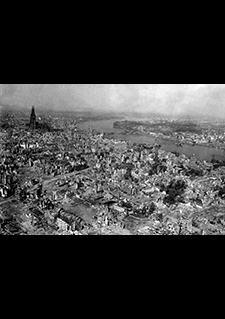Bombardments of German Cities
The British intensified their bombardments of cities and industrial sites over the course of 1942. In the wake of “1000 bomber raids” that carpet bombed German cities – Lübeck on March 28 and 29, 1942 and Cologne on May 30 and 31, 1942 –the first American daylight bombardment on January 27, 1943 heralded an intensity and destructiveness unprecedented in history.
As of 1943, the British and the Americans owned the airspace over Germany. Hitler’s “Fortress Europe” had no roof as the American president Roosevelt triumphantly concluded.
Large-scale attacks, such as on Hamburg on July 24 and 30, 1943 with 30,000 dead, and routine nighttime attacks, such as on Berlin beginning on November 18, 1943, became a grim reality of war for the German populace. School-age children as well as pregnant women and mothers with infants were evacuated from the industrial, urban regions threatened by bombing to rural areas such as Pomerania, the Bavarian East March or Salzburg in order to protect them.
While the adults found accommodations – organized by the National Socialist People's Welfare – with host families, the youth were placed in camps under the overall control of the Hitler Youth and educated wholly in the spirit of Nazi ideology – without any religious components, for instance; toward the end of the war, even entire schools including all grades were moved to areas that seemed safe.
The failure to observe promises made at parents’ meetings about the denominational care of evacuated children, soon aroused displeasure among parents with denominational ties, however (Boberach, Meldungen aus dem Reich 15, p. 5900). An SD report from October 21, 1943 addressed this:
In this region, a number of young people have not been sent so far because their parents categorically refused to have them relocated. To the extent it has been observable here, a substantial part come from circles of Catholic parents who fear that their children are not receiving sufficient religious guidance are being educated in the camp in the Nazi spirit instead (Münster)....
Circles with denominational ties hold the opinion that the entire evacuation only serves the purpose of separating young people from their parental homes in order to raise them in camps to be heretics (Münster).
In cases when the religious instruction promised at parents’ meetings was discontinued, the camp director or headmaster promptly received written demands from parents to reintroduce religious instruction immediately. The uniformly drafted letters reveal the clergy’s influence (Boberach, Meldungen aus dem Reich 15, p. 5900).
An SD report from June 1, 1944 examined public opinion in the face of the bombardments:
German citizens are growing more and more nervously anxious about the air war. Large circles are “running for their lives”. In general, the increasing air raids, even in territories hitherto located “far from the action” such as the Sudetenland, Oberdonau and Wartheland, are noted with great concern (e.g. Linz, Reichenberg).
It is very depressing that both fighter and bomber squadrons as well as individual planes spend hours over Reich territory without being noticeably stopped from doing so. “When will this terrible scourge finally come to an end once and for all?” is the “perpetual question” in numerous discussions about the war (Boberach, Meldungen aus dem Reich 17, p. 6565).
The destruction of Dresden, which was inundated with refugees, on February 13 and 14, 1945 marked the equally bloody and – even militarily – senseless culmination of the bombing war. Germany had long since lost the war at this time.
Source / title
- U.S. Department of Defense. Dept. of the Army. Office of the Chief Signal Officer, public domain

